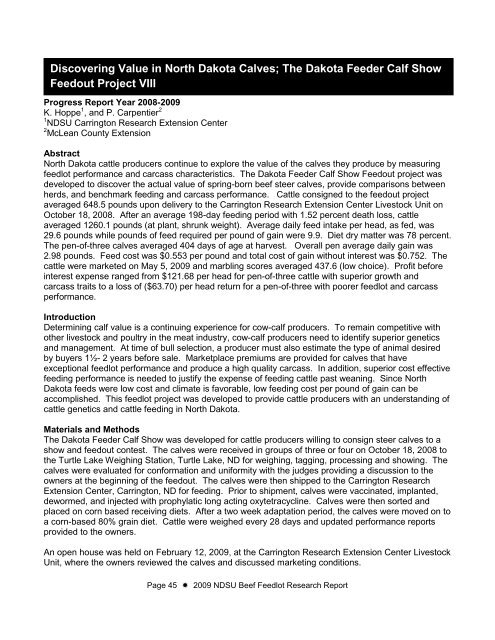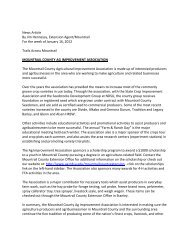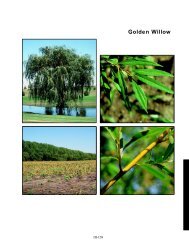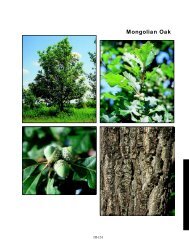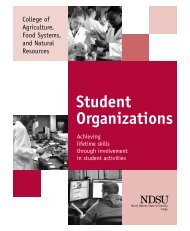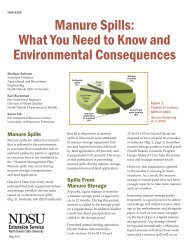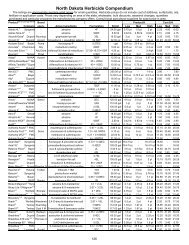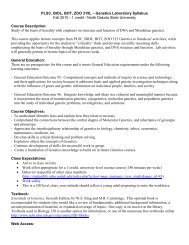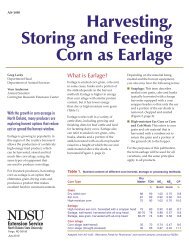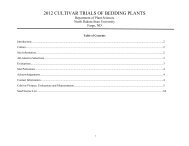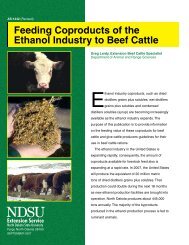NDSU Beef Feedlot - NDSU Agriculture - North Dakota State ...
NDSU Beef Feedlot - NDSU Agriculture - North Dakota State ...
NDSU Beef Feedlot - NDSU Agriculture - North Dakota State ...
Create successful ePaper yourself
Turn your PDF publications into a flip-book with our unique Google optimized e-Paper software.
Discovering Value in <strong>North</strong> <strong>Dakota</strong> Calves; The <strong>Dakota</strong> Feeder Calf Show<br />
Feedout Project VIII<br />
Progress Report Year 2008-2009<br />
K. Hoppe 1 , and P. Carpentier 2<br />
1 <strong>NDSU</strong> Carrington Research Extension Center<br />
2 McLean County Extension<br />
Abstract<br />
<strong>North</strong> <strong>Dakota</strong> cattle producers continue to explore the value of the calves they produce by measuring<br />
feedlot performance and carcass characteristics. The <strong>Dakota</strong> Feeder Calf Show Feedout project was<br />
developed to discover the actual value of spring-born beef steer calves, provide comparisons between<br />
herds, and benchmark feeding and carcass performance. Cattle consigned to the feedout project<br />
averaged 648.5 pounds upon delivery to the Carrington Research Extension Center Livestock Unit on<br />
October 18, 2008. After an average 198-day feeding period with 1.52 percent death loss, cattle<br />
averaged 1260.1 pounds (at plant, shrunk weight). Average daily feed intake per head, as fed, was<br />
29.6 pounds while pounds of feed required per pound of gain were 9.9. Diet dry matter was 78 percent.<br />
The pen-of-three calves averaged 404 days of age at harvest. Overall pen average daily gain was<br />
2.98 pounds. Feed cost was $0.553 per pound and total cost of gain without interest was $0.752. The<br />
cattle were marketed on May 5, 2009 and marbling scores averaged 437.6 (low choice). Profit before<br />
interest expense ranged from $121.68 per head for pen-of-three cattle with superior growth and<br />
carcass traits to a loss of ($63.70) per head return for a pen-of-three with poorer feedlot and carcass<br />
performance.<br />
Introduction<br />
Determining calf value is a continuing experience for cow-calf producers. To remain competitive with<br />
other livestock and poultry in the meat industry, cow-calf producers need to identify superior genetics<br />
and management. At time of bull selection, a producer must also estimate the type of animal desired<br />
by buyers 1½- 2 years before sale. Marketplace premiums are provided for calves that have<br />
exceptional feedlot performance and produce a high quality carcass. In addition, superior cost effective<br />
feeding performance is needed to justify the expense of feeding cattle past weaning. Since <strong>North</strong><br />
<strong>Dakota</strong> feeds were low cost and climate is favorable, low feeding cost per pound of gain can be<br />
accomplished. This feedlot project was developed to provide cattle producers with an understanding of<br />
cattle genetics and cattle feeding in <strong>North</strong> <strong>Dakota</strong>.<br />
Materials and Methods<br />
The <strong>Dakota</strong> Feeder Calf Show was developed for cattle producers willing to consign steer calves to a<br />
show and feedout contest. The calves were received in groups of three or four on October 18, 2008 to<br />
the Turtle Lake Weighing Station, Turtle Lake, ND for weighing, tagging, processing and showing. The<br />
calves were evaluated for conformation and uniformity with the judges providing a discussion to the<br />
owners at the beginning of the feedout. The calves were then shipped to the Carrington Research<br />
Extension Center, Carrington, ND for feeding. Prior to shipment, calves were vaccinated, implanted,<br />
dewormed, and injected with prophylatic long acting oxytetracycline. Calves were then sorted and<br />
placed on corn based receiving diets. After a two week adaptation period, the calves were moved on to<br />
a corn-based 80% grain diet. Cattle were weighed every 28 days and updated performance reports<br />
provided to the owners.<br />
An open house was held on February 12, 2009, at the Carrington Research Extension Center Livestock<br />
Unit, where the owners reviewed the calves and discussed marketing conditions.<br />
Page 45 2009 <strong>NDSU</strong> <strong>Beef</strong> <strong>Feedlot</strong> Research Report


